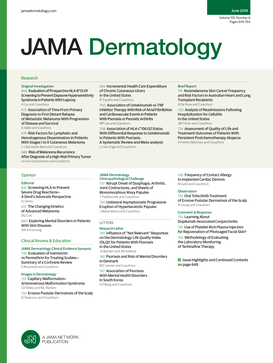Cord Blood Serum Levels of IL-31 and CCL17, Cutaneous Markers, and Development of Atopic Dermatitis
IF 11.5
1区 医学
Q1 DERMATOLOGY
引用次数: 0
Abstract
ImportanceAtopic dermatitis (AD) is the most prevalent chronic skin condition characterized by inflammation and itching. Currently, there is no reliable method for identifying which newborns might have an increased risk of developing AD.ObjectiveTo evaluate the predictive value of serological biomarkers, such as CCL17/thymus- and activation-regulated chemokine, CCL18, CCL22, CCL27, IL-31, and thymus stromal lymphopoietin, with transepidermal water loss (TEWL) and hydration rate and the development of AD in infants.Design, Setting, and ParticipantsThis observational prospective study included 40 consecutive full-term newborns from a single university hospital in Pisa, Italy. The cutaneous markers of infants were assessed at 1, 6, and 12 months of age, while the biomarkers from the 10-mL sample of cord blood taken at birth were measured after delivery. Data were collected from March to December 2018 and analyzed from January to April 2019.Main Outcomes and MeasuresLevel of serological biomarkers associated with TEWL and hydration rate, as well as the emergence of AD during the first 12 months of life.ResultsAll 40 included infants (27 male [68%]) completed the study. At 6 months, 16 infants presented symptoms and signs of AD (AD group) and 24 did not (non-AD group). Infants with AD signs had statistically significant anterior cubital fossa TEWL values at 1, 6, and 12 months of age compared to those without AD signs. No statistically significant correlations were observed between the TEWL measured at the anterior part of knee and hydration rate at the anterior cubital fossa at first month in the 2 groups. With regard to the blood biomarkers, at birth those in the AD group vs the non-AD group had statistically significant higher levels of CCL17/thymus- and activation-regulated chemokine (median [IQR], 716 [509-951] pg/mL vs 419 [24-566] pg/mL;脐带血血清中 IL-31 和 CCL17 的水平、皮肤标记物与特应性皮炎的发展
重要性特应性皮炎(AD)是以炎症和瘙痒为特征的最常见慢性皮肤病。目的 评估血清学生物标志物(如 CCL17/胸腺和活化调节趋化因子、CCL18、CCL22、CCL27、IL-31 和胸腺基质淋巴细胞生成素)与经表皮失水率 (TEWL) 和水合率以及婴儿 AD 发病的预测价值。这项前瞻性观察研究包括来自意大利比萨一家大学医院的 40 名连续足月新生儿。在婴儿1、6和12个月大时对其皮肤标记物进行评估,同时在分娩后测量出生时采集的10毫升脐带血样本中的生物标记物。数据收集时间为 2018 年 3 月至 12 月,分析时间为 2019 年 1 月至 4 月。主要结果和测量与 TEWL 和水合率相关的血清学生物标志物水平,以及出生后前 12 个月出现 AD 的情况。结果所有 40 名纳入研究的婴儿(27 名男性 [68%])均完成了研究。6 个月大时,16 名婴儿出现注意力缺失症的症状和体征(注意力缺失症组),24 名婴儿没有(非注意力缺失症组)。与无 AD 征兆的婴儿相比,有 AD 征兆的婴儿在 1、6 和 12 个月大时肘窝前 TEWL 值具有统计学意义。在两组中,膝关节前部测量的 TEWL 与 1 个月大时肘窝前部的水合率之间没有统计学意义上的相关性。在血液生物标志物方面,出生时,AD 组与非 AD 组相比,CCL17/胸腺和活化调节趋化因子(中位数 [IQR], 716 [509-951] pg/mL vs 419 [24-566] pg/mL;P = .003)和 IL-31 (中位数 [IQR], 212 [114-409] pg/mL vs 97 [52-277] pg/mL;P = .04);相反,胸腺基质淋巴细胞生成素(中位数 [IQR], 105 [66-295] pg/mL vs 88 [43-187] pg/mL)、CCL18(中位数 [IQR]、1236 [1115-1605] pg/mL vs 1255 [1188-1677] pg/mL)、CCL22(中位数[IQR],1032 [936-1454] pg/mL vs 1096 [932-1536] pg/mL)和 CCL27(中位数[IQR],172 [122-251] pg/mL vs 120 [90-265] pg/mL)。结论和相关性在这项观察性研究中,对肘窝前区 TEWL 的分析发生在 AD 临床症状出现之前,并与之相关。细胞因子的定量分析表明,评估脐带血血清中 CCL17 和 IL-31 的水平可为识别可能易患 AD 的新生儿提供新的视角。还需要更大规模的研究来验证这些发现。
本文章由计算机程序翻译,如有差异,请以英文原文为准。
求助全文
约1分钟内获得全文
求助全文
来源期刊

JAMA dermatology
DERMATOLOGY-
CiteScore
14.10
自引率
5.50%
发文量
300
期刊介绍:
JAMA Dermatology is an international peer-reviewed journal that has been in continuous publication since 1882. It began publication by the American Medical Association in 1920 as Archives of Dermatology and Syphilology. The journal publishes material that helps in the development and testing of the effectiveness of diagnosis and treatment in medical and surgical dermatology, pediatric and geriatric dermatology, and oncologic and aesthetic dermatologic surgery.
JAMA Dermatology is a member of the JAMA Network, a consortium of peer-reviewed, general medical and specialty publications. It is published online weekly, every Wednesday, and in 12 print/online issues a year. The mission of the journal is to elevate the art and science of health and diseases of skin, hair, nails, and mucous membranes, and their treatment, with the aim of enabling dermatologists to deliver evidence-based, high-value medical and surgical dermatologic care.
The journal publishes a broad range of innovative studies and trials that shift research and clinical practice paradigms, expand the understanding of the burden of dermatologic diseases and key outcomes, improve the practice of dermatology, and ensure equitable care to all patients. It also features research and opinion examining ethical, moral, socioeconomic, educational, and political issues relevant to dermatologists, aiming to enable ongoing improvement to the workforce, scope of practice, and the training of future dermatologists.
JAMA Dermatology aims to be a leader in developing initiatives to improve diversity, equity, and inclusion within the specialty and within dermatology medical publishing.
 求助内容:
求助内容: 应助结果提醒方式:
应助结果提醒方式:


